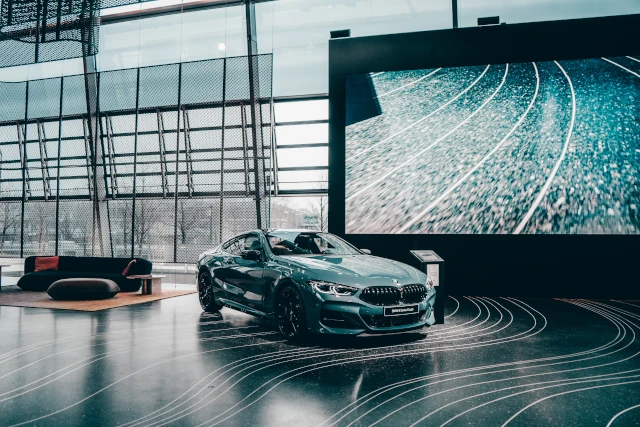BMW, renowned for its luxury vehicles, adopts a marketing strategy that is a blend of traditional and modern techniques, tailored to its high-end customer base. Here’s a detailed look at the different strands of BMW’s marketing strategy.
Target Audience

BMW’s marketing strategy meticulously identifies and caters to a unique segment of the automotive market: the affluent consumer who views a vehicle not merely as a means of transportation but as a symbol of personal achievement and status. This target audience is discerning, with a keen eye for quality, design, and technological innovation. They are individuals who see their choice of vehicle as an extension of their lifestyle and personal brand, making the decision to purchase a BMW both a practical and an aspirational one.
The typical BMW customer falls into a higher income bracket and often holds a position of influence or esteem in their professional field. These are individuals who appreciate the finer things in life and are willing to invest in a product that not only meets their high standards for performance and comfort but also resonates with their sense of identity. BMW understands that its customers are looking for more than just luxury in a car; they are seeking a unique driving experience that aligns with their high expectations and life aspirations.
The brand’s marketing efforts are thus centered around understanding and appealing to these sophisticated tastes. BMW’s advertisements, for instance, do more than showcase the technical specifications of the vehicles; they create a narrative around the lifestyle and experiences that owning a BMW can offer. This storytelling approach is crucial in connecting with an audience that values experiences and personal expression as much as the functional aspects of the vehicle.
Furthermore, BMW recognizes that its customers are not a monolithic group. The brand, therefore, tailors its messaging to appeal to various sub-segments within this affluent demographic. From the young, successful entrepreneur to the established business leader, BMW’s marketing communicates a different facet of the brand that resonates with each subgroup. This nuanced understanding of its target audience ensures that BMW’s marketing strategy remains both relevant and appealing across a spectrum of affluent consumers, each with their distinct preferences and aspirations.
In essence, BMW’s marketing strategy is adept at weaving the brand into the aspirational narrative of its target audience. It’s not just about selling cars; it’s about selling a lifestyle and a symbol of success that resonates deeply with the affluent consumer’s identity and aspirations.
Brand Positioning
BMW’s brand positioning is a masterful blend of luxury, performance, and innovation, distinguishing it in the competitive automotive market. The company’s tagline, “The Ultimate Driving Machine,” is not just a slogan but a reflection of its commitment to engineering excellence and superior driving experience. This positioning strategy is deeply rooted in the brand’s history and is consistently communicated through every aspect of its operations, from product design to marketing campaigns.

At the heart of BMW’s brand positioning is the promise of a premium experience. Every BMW vehicle is designed with meticulous attention to detail, ensuring that both the interior and exterior exude luxury and sophistication. The brand appeals to customers who seek more than just a car – they seek a statement of their personal success and style. This focus on luxury is complemented by a relentless pursuit of innovation. BMW is known for its cutting-edge technology and engineering, continually pushing the boundaries of what is possible in automotive design.
Performance is another cornerstone of BMW’s brand identity. The brand has built a reputation for producing vehicles that offer dynamic handling and powerful engines, delivering an exhilarating driving experience. This emphasis on performance attracts customers who are passionate about driving and appreciate the precision and agility of BMW cars. The brand’s involvement in motorsports further reinforces this aspect of its identity, connecting with an audience that values speed and high performance.
However, BMW’s brand positioning extends beyond the product itself. The company’s customer service and dealership experience are also tailored to align with its luxury and performance image. Customers expect and receive high levels of service, reinforcing the premium nature of the brand at every touchpoint.
BMW’s consistent focus on luxury, innovation, and performance has helped it build a strong brand identity that resonates with its target audience. This strategic positioning not only differentiates BMW from its competitors but also creates a loyal customer base that values the unique combination of qualities that BMW represents. The brand’s ability to maintain this positioning over time, adapting to changing market trends while staying true to its core values, is a testament to its strong marketing acumen.
Product Strategy
BMW’s product strategy is a critical element of its overall marketing approach, showcasing a deep understanding of its market and an unerring commitment to quality. At the core of this strategy is a diverse lineup of vehicles, each embodying the brand’s signature blend of luxury, performance, and technological innovation. From sleek sedans to versatile SUVs, BMW’s range caters to a variety of customer needs and preferences, all while maintaining the high standards the brand is known for.

The company’s approach to product development is heavily customer-centric. BMW conducts extensive research to understand the evolving needs and desires of its target audience. This insight informs the design and features of each model, ensuring that they not only meet but exceed customer expectations. For instance, BMW’s luxury sedans offer a refined driving experience, combining elegance with powerful performance, while their SUVs provide versatility without compromising on style or driving dynamics.
A key aspect of BMW’s product strategy is its focus on technological innovation. The brand is a leader in incorporating cutting-edge technology into its vehicles, ranging from advanced safety features to sophisticated infotainment systems. These technological advancements not only enhance the functionality and safety of BMW cars but also add an element of futuristic luxury, appealing to tech-savvy consumers.
In recent years, BMW has also placed a significant emphasis on sustainability, recognizing the growing consumer interest in environmentally friendly vehicles. The development of electric and hybrid models underlines BMW’s commitment to sustainable mobility. These eco-friendly vehicles, such as the BMW i Series, offer a combination of innovative design, reduced emissions, and the high performance that customers expect from the brand.
By offering a wide range of high-quality vehicles that cater to different preferences and needs, BMW’s product strategy plays a crucial role in its overall marketing success. This strategy not only helps the brand to attract a broad customer base but also strengthens its position as a leader in the luxury automotive segment. BMW’s ability to balance traditional luxury with innovative technology and sustainability demonstrates its agility in adapting to market trends while staying true to its core brand values.
Price Strategy
BMW’s pricing strategy is an essential component of its market positioning, reflecting the brand’s status as a purveyor of luxury and quality. Adopting a premium pricing model, BMW sets its prices higher than the average market rates. This strategy is not merely about placing a higher price tag on its products; it is a deliberate move to reinforce the brand’s luxury status and appeal to a customer base that values exclusivity and prestige as much as the product itself.
The rationale behind this premium pricing is rooted in the perception of value. BMW customers are willing to pay more for a vehicle that symbolizes status, success, and quality. The higher price is seen as a testament to the superior craftsmanship, advanced technology, and exceptional performance that BMW vehicles offer. This pricing approach also creates a sense of exclusivity, making BMW cars more desirable to consumers who seek to distinguish themselves.
BMW’s pricing strategy is also reflective of the brand’s commitment to innovation and quality. The investment in research and development, the use of high-quality materials, and the incorporation of cutting-edge technology justify the premium prices of BMW vehicles. Customers recognize that they are not just paying for the car but also for the years of engineering expertise and innovation that it represents.

This premium pricing strategy extends beyond the initial purchase price. BMW ensures that the ownership experience aligns with the expectations set by its high price point. This includes exceptional customer service, comprehensive warranties, and maintenance packages, all of which add value to the ownership experience and justify the premium pricing.
The effectiveness of BMW’s pricing strategy is evident in its strong brand loyalty and customer retention rates. By maintaining high price points, BMW not only upholds its image as a luxury brand but also attracts a specific segment of the market that values and is willing to invest in a premium automotive experience. This approach has helped BMW maintain its position as a leading luxury car manufacturer and has become a key aspect of its overall marketing success.
Distribution Strategy
BMW’s distribution strategy is a critical facet of its overall marketing approach, carefully crafted to complement its luxury brand image. The company employs a selective distribution model, ensuring its vehicles are sold through exclusive showrooms that reflect the brand’s high-end positioning. This strategy not only controls the environment in which its products are sold but also enhances the overall customer experience, a crucial aspect for a luxury brand like BMW.
The exclusive showrooms are more than just car dealerships; they are designed to provide a premium experience. From the architectural design to the interior layout, every detail is meticulously planned to exude sophistication and elegance. These showrooms serve as the physical embodiment of the brand, creating a space that aligns with the luxury and quality associated with BMW vehicles. The sales staff in these showrooms are highly trained, knowledgeable about the brand’s history, vehicle specifications, and are skilled in catering to the needs of a discerning clientele.
In addition to physical showrooms, BMW has also embraced digital platforms for its distribution strategy. Recognizing the growing importance of online channels, especially among younger, tech-savvy customers, BMW offers extensive online resources. Customers can explore models, customize their vehicle, and even initiate the purchase process online. This digital integration not only broadens BMW’s reach but also provides convenience and flexibility to customers, enhancing their overall experience with the brand.
BMW’s distribution strategy extends beyond the point of sale. The brand places significant emphasis on after-sales service, an integral part of the luxury car ownership experience. BMW offers comprehensive maintenance plans, warranty programs, and customer support services, all designed to maintain the high standards of customer satisfaction and brand loyalty. This after-sales service is available through a network of authorized service centers, ensuring that the quality of service is consistent with the brand’s luxury image.
This strategic approach to distribution allows BMW to maintain control over its brand image and customer experience. By combining exclusive physical showrooms with a strong online presence and exceptional after-sales service, BMW has created a distribution network that not only aligns with its luxury positioning but also addresses the evolving needs and preferences of its customers. This thoughtful approach to distribution is a key element in BMW’s sustained success in the luxury automotive market.
Promotion Strategy
BMW’s promotion strategy is a multi-faceted approach designed to reinforce its position as a premium automotive brand and to connect with its diverse customer base. This strategy integrates a variety of promotional tactics, each chosen to reflect the brand’s values of luxury, performance, and innovation, while also engaging with customers at multiple touchpoints.
At the core of BMW’s promotional activities is its advertising campaigns. These campaigns are carefully crafted to capture the essence of the BMW brand – a blend of luxury, sophistication, and technological advancement. BMW’s advertisements often focus more on the experience of owning and driving a BMW rather than just the technical specifications of the cars. This approach resonates with their target audience, who are seeking not just a car, but a lifestyle choice. The ads are visually stunning, often featuring BMW cars in dynamic and aspirational settings, which reinforces the brand’s image as a symbol of success and achievement. BMW utilizes a mix of traditional media like TV and print, as well as digital platforms, to reach a wider audience and to cater to the changing media consumption habits of its customers.
Sponsorships and event partnerships form another critical component of BMW’s promotional strategy. The brand is often associated with high-profile sports events, such as golf and sailing tournaments, which align with the interests and lifestyle of its target demographic. BMW also partners with cultural events like art fairs and fashion shows, which helps to position the brand within a context of sophistication and elegance. These sponsorships are strategic, aiming to associate BMW with experiences that reflect the brand’s core values and resonate with its customers’ lifestyles.
Digital marketing is an increasingly important part of BMW’s promotional mix. The brand leverages social media platforms to engage with a younger, digitally savvy audience. Through platforms like Instagram and Twitter, BMW showcases its latest models, shares brand stories, and interacts directly with customers and fans. This online presence is not just about promotion; it’s about building a community around the brand. BMW also uses online advertising, including search engine marketing and display ads, to reach potential customers actively seeking information about luxury cars.
Influencer marketing is another modern tactic employed by BMW. By partnering with influencers who align with the brand’s image, BMW reaches out to new audiences in a more organic and authentic way. These influencers, often from the fields of fashion, technology, or lifestyle, share their experiences with BMW vehicles with their followers, creating a sense of aspiration and desire.
An often-overlooked aspect of BMW’s promotional strategy is its focus on the customer experience. Every interaction a customer has with the brand, from visiting a showroom to after-sales service, is an opportunity for promotion. BMW ensures that these experiences are in line with its brand values, thereby reinforcing the customer’s decision to choose BMW. The sales staff are trained not just to sell cars, but to provide a luxury buying experience, while the after-sales service is designed to ensure customer satisfaction and loyalty.
Public relations also play a significant role in BMW’s promotional strategy. The brand actively manages its public image through press releases, media events, and by maintaining relationships with journalists and industry influencers. These efforts help BMW to control its narrative in the public domain, ensuring that its messages are communicated clearly and effectively.
Lastly, BMW invests in community engagement and corporate social responsibility initiatives. These efforts may not directly promote BMW products, but they contribute significantly to building a positive brand image. By involving itself in community projects and environmental initiatives, BMW demonstrates its commitment to societal values, which resonates with customers who are increasingly conscious of corporate ethics and responsibility.
In conclusion, BMW’s promotion strategy is a comprehensive blend of traditional and modern marketing tactics, all aligned with its brand values of luxury, performance, and innovation. By effectively combining advertising, sponsorships, digital marketing, influencer partnerships, customer experience, public relations, and community engagement, BMW has created a robust promotional framework that not only increases brand visibility but also strengthens customer loyalty and attracts new customers to its luxury automotive experience.
BMW’s Marketing Strategy Summarized
BMW’s marketing strategy is a well-balanced mix of traditional values and modern approaches. By focusing on a specific target audience and maintaining its brand prestige through quality, innovation, and a premium customer experience, BMW continues to strengthen its position as a leading luxury car manufacturer.
- Target Audience Focus: Concentrates on affluent consumers who view their vehicle as a symbol of status and luxury, valuing quality, performance, and prestige.
- Brand Positioning: Positioned as a synonym for luxury, performance, and innovation, encapsulated in the tagline “The Ultimate Driving Machine.”
- Diverse Product Lineup: Offers a range of luxury cars and SUVs, emphasizing superior performance, cutting-edge technology, and premium design, including sustainable mobility options.
- Premium Pricing Strategy: Adopts a high-end pricing model to reinforce the luxury status and cater to customers who associate price with quality and exclusivity.
- Selective Distribution Approach: Sells through exclusive showrooms that align with the brand’s luxury image, providing a consistent and premium brand experience.
- Multifaceted Promotion Strategy: Utilizes a mix of traditional advertising, sponsorships, digital marketing, influencer partnerships, and a focus on premium customer experiences.
- Emphasis on Innovation and Technology: Invests heavily in R&D to integrate advanced technology in vehicles, maintaining an image as an industry innovator.
- Sustainability Commitment: Increasing focus on environmentally friendly vehicles and corporate practices, addressing the growing consumer interest in sustainability.
- Customer-Centric Approach: Tailors product features and marketing messages to meet the diverse preferences within its affluent target demographic.
- Building Brand Loyalty: Strives for strong brand loyalty and customer retention through high-quality products, exceptional service, and a consistent luxury experience.

